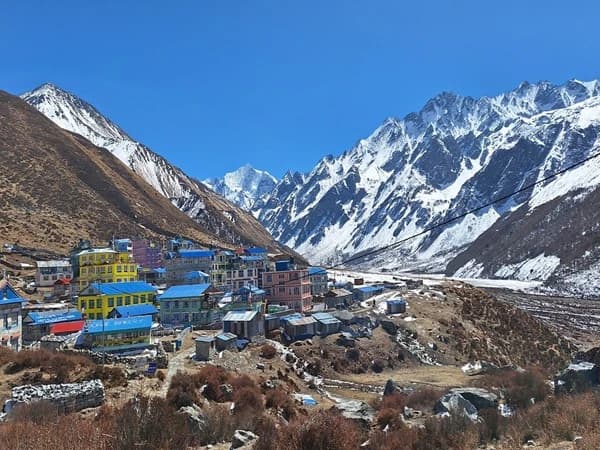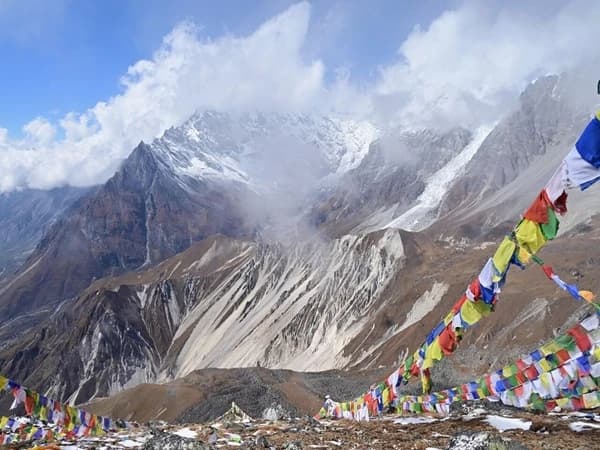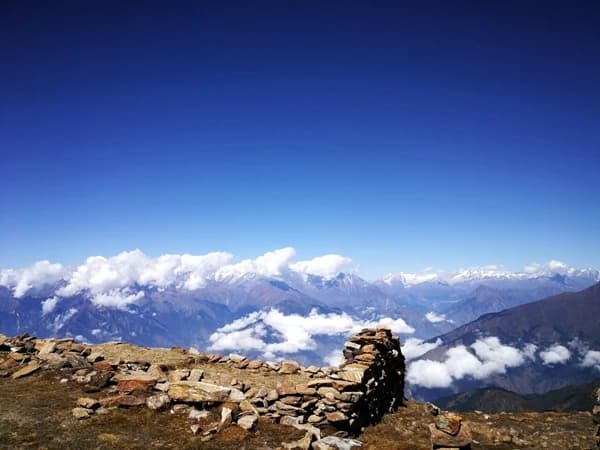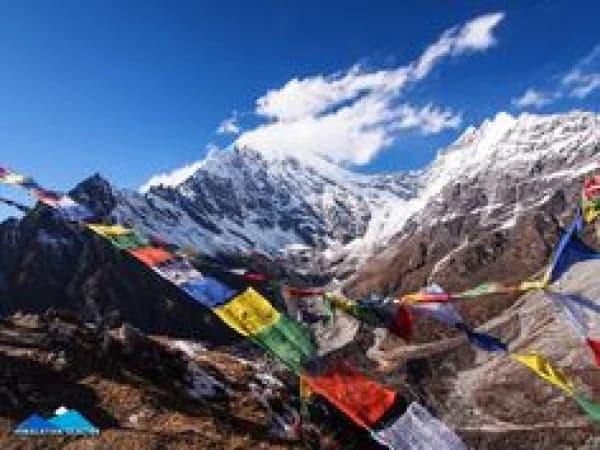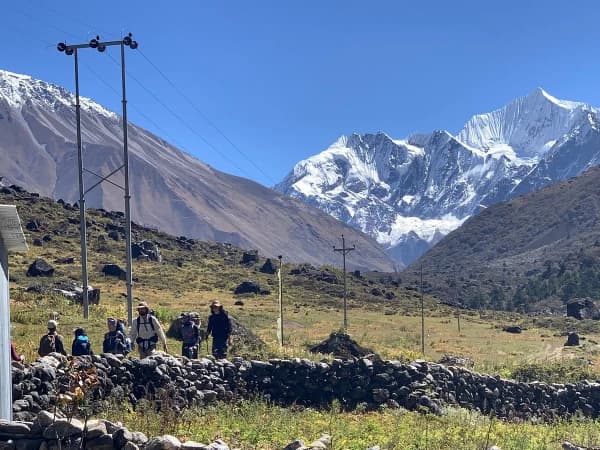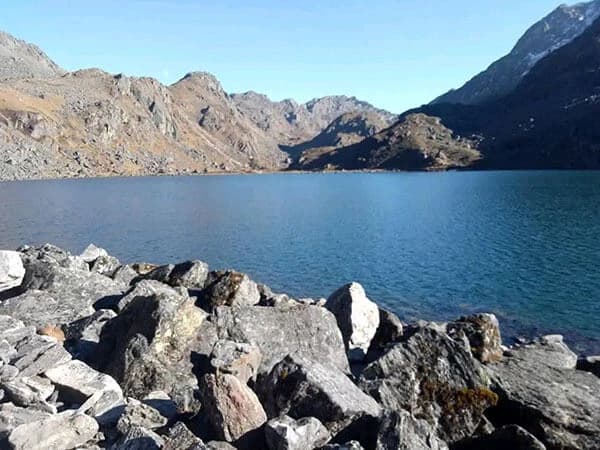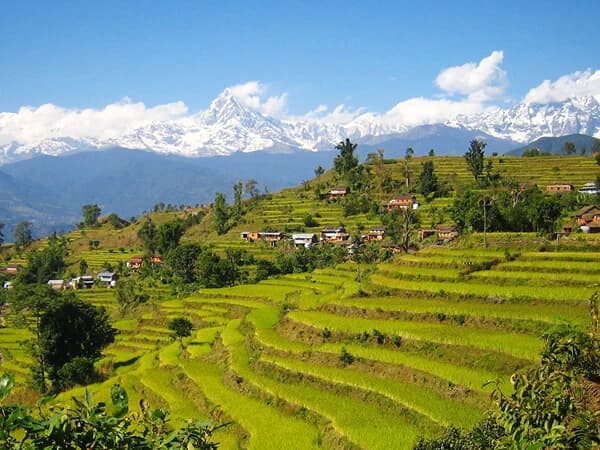The Langtang Region is situated in the Rasuwa District and is only 80 km North of the capital, Kathmandu. The Langtang National Park is the first Himalayan national park in Nepal, it covers a total area of 1710 km which includes any subtropical forest to glaciers.
The valley is named after the Langtang Lirung (7,234 m); visitors will encounter a steep colorful jungle, vast alpine basins, and towering rugged glaciers. As well as geography, the trek through the Langtang Region is rich in cultural experiences of Tamang culture, Sherpa culture, teahouse villages, stone monasteries (i.e., Kyanjin Gompa), mani walls, prayer flags, yak herding, and first-hand examples of life in the Himalayas.
The rich cultural heritage and resilient nature of these communities, especially in the aftermath of the earthquakes in 2015, beckons. And so does the possibility of drinking butter tea, a common tradition in these communities that often embraces culture, hospitality, and a shared life. The trekking trails climb up from verdant forests of rhododendron and oak to alpine meadows above sacred glacial formations like the Langtang Glacier. And the wildlife will not disappoint as well: red panda, Himalayan tahr, black bear, and possibly rare snow leopard all frequent the region.
Not as popular with tourists as Everest or Annapurna, Langtang has just as great mountains as Everest and Annapurna; Langtang Lirung, Gangchempo, Dorje Lakpa - just a week's trek from Syabrubesi.
The hiking with no obstruction from trees to view mountain-tops reaching for the skies is great here - like Tserko Ri (4984 m) or Yala Peak (5500 m). The views available here are mind-blowing. The adventure is accessible yet at the same time feels authentic and rugged and wild, a real Himalayan adventure. It is spiritual, scenic, and culturally abundant, an eye-opening opportunity, and an unforgettable trek in this magical backyard of Nepal.
Quick Info:
- Geography: Himalayan region covering subtropical to glacial zones
- Location: Rasuwa District, ~80 km north of Kathmandu
- Park: Within Langtang National Park (Nepal’s first Himalayan reserve since 1976)
- Difficulty: Moderate (a few steep parts, altitude up to ~5,000 m)
- Trek Distance: ~60–80 km (based on route)
- Duration: 7–12 days standard trek
- Average Walk: ~5–7 hrs/day
- Highest Climb: Tsergo Ri (~4,985 m) or Kyanjin Ri (~4,773 m)
- Start/End: Loop trek starting and finishing at Syabrubesi (to accommodate the trek); ~1,460 m (6–8 hr drive from Kathmandu).
- Ethnic Groups: Most are Tamang (Tibetan‑Buddhist culture)
- Accommodation: Basic tea‑houses and lodges along the way
- Transport: Shared/private jeep or bus to the trailhead; remainder on foot
- Permits: Entrance to the park + TIMS card (~USD 30 + 10)
- Guide Rule: As of Feb 2026, The solo trek rule has ended and there is no solo trekking in Nepal, thus a guide you will now be required.
Why Choose Langtang Region for Trekking?
- Easily accessible location to Kathmandu, making it one of the easiest trekking locations in the Himalayas of Nepal.
- Stunning mountain vistas of many peaks, including Langtang Lirung, Dorje Lakpa, and Yala.
- Very nice cultural experience, with many villages along the trek that are authentically Tamang and Tibetan influenced.
- As part of Langtang National Park, there is an interesting array of flora and fauna, including the elusive red panda.
- Possibility of trekking to a very sacred place, such as the glacial Gosainkunda Lakes, which has great significance for both Hindus and Buddhists.
- Less traveled and less crowded than other routes to Everest and Annapurna for those who prefer a quiet and peaceful trekking experience.
- The trails traverse beautiful forests of rhododendron, bamboo, and pine, often at their most colorful in spring.
- Visit Kyanjin Gompa, the famous monastery, and try yak cheese at a few local cheese factories.
- This area has recovered from the 2015 earthquake and is welcoming trekkers once again, along with their traditional hospitality, with updated and improved infrastructure.
- The trek will accommodate every level of trekkers, from novices to very experienced, with many options for an itinerary and average altitude trekking.
Top Recommended Langtang Trek Package Options: Which One Suits You?
Langtang Valley Trekking - 8 Days
The Langtang Valley Trek is a spectacular 8-day trek in Nepal that brings you through Langtang National park. It begins with a drive from Kathmandu to Syabrubesi and has some trekking at altitude in sub-tropical and alpine forests. You will trek through dense rhododendron forests and subalpine and alpine meadows, which are the gateway to Kyanjin Gompa. Here you will be at the foot of an impressive mountain range where Langtang Lirung and Dorje Lakpa stand out among others.
There will be opportunities to visit a couple of Buddhist monasteries, a yak cheese farm and optional day hikes to Kyanjin Ri or Tsergo Ri with stunning views along the whole long trek. This will be a moderately challenging trek and a cultural experience for anyone looking to experience the diversity that Nepal has to offer.
| Category | Highlights |
| Maountains | Views from Langtang Lirung, Dorje Lakpa, and Ganesh Himal; optional hikes to Kyanjin Ri (4,773 m) or Tsergo Ri (4,985 m) |
| Flora | Colourful rhododendron forests, wildflower-filled alpine meadows, and tropical vegetation |
| Fauna |
Chance to see red pandas, Himalayan tahr, musk deer, langur monkeys, and 250+ species of birds |
| Culture | Interact with Tamang and Sherpa communities; visit Buddhist monasteries and traditional villages |
| Unique sites | Yak cheese factory in Kyanjin, Langtang Lirung Glacier, Langtang National Park |
| Accessibility | 6–8 hour road drive from Kathmandu to Syabrubesi with moderate trek difficulty |
Langtang Valley Trek – 10 Days
The 10 days Langtang Valley Trek will first require you to take a drive from Kathmandu to Syabrubesi before you start trekking up through the subtropical forest and towards the dense rhododendron forest and alpine meadows. The trek will take you all the way to Kyanjin Gompa, which is located in a beautiful and quiet village at the base of the mountains and surrounded by many prominent peaks, including Langtang Lirung and Dorje Lakpa. Your trek will also include visits to Buddhist monasteries and the Yak Cheese Factory and the option to hike up onto Kyanjin Ri or Tsergo Ri for some of the most stunning views of the valley and surrounding peaks.
| Category | Highlights |
| Maountains |
Panoramic vistas of Langtang Lirung, Dorje Lakpa, and Ganesh Himal; optional hikes to Kyanjin Ri (4,770 m) or Tsergo Ri (4,985 m) |
| Flora | Beautiful rhododendron forests, alpine meadows filled with wildflowers, and subtropical vegetation |
| Fauna |
Wildlife viewing of red pandas, Himalayan black bears, langur monkeys, musk deer, pheasants, and much more that live within the National Park |
| Culture |
Cultural interactions with Tamang/Tibetan-Buddhist people; visits to monasteries, prayer flags, mani walls in villages and Kyanjin Gompa |
| Unique sites | Yak cheese factory in Kyanjin, Langtang Lirung Glacier, Langtang National Park |
| Accessibility | 6-8 hour drive from Kathmandu to Syabrubesi; moderate difficulty trek |
Tamang Heritage Trek – 11 Days
Tamang Heritage Trek is an 11-day trek in the Langtang Valley region that provides trekkers with many variations of nature and culture. The trek begins with a ride from Kathmandu to Syabrubesi (which is near the start of all trails in the Langtang region), will wind through many rhododendron forests and terraced fields, and pass through many Tamang villages. The trek will take you to many ancient monasteries and natural hot springs in Tatopani. During the trek, you will also have an opportunity to meet the Tamang people face to face and get a feel for their hospitality, culture, and way of life.
| Category | Highlights |
| Maountains | Ganesh Himal and Langtang Himal |
| Flora | rhododendron forests, terraced fields and alpine meadows |
| Fauna |
Langur monkeys and other birds. |
| Culture |
Tamang communities and monasteries, prayer flags, traditional villages |
| Unique sites | Natural hot springs in Tatopani |
| Accessibility | 6-7 hour drive Kathmandu to Syabrubesi (moderate trek difficulty) |
Langtang Valley with Gosaikunda Trek – 10 Days
The Langtang Valley & Gosaikunda Trek is a 10-day trek that brings together the unmatched beauty of the Langtang Valley and the sacred site of Gosaikunda Lake.
To begin the trek, you first need to drive from Kathmandu to Syabrubesi. From Syabrubesi, you will trek through the forests and traditional villages, and your destination will be Kyanjin Gompa. Then, from Kyanjin Gompa to Gosaikunda Lake, you trek over alpine meadows and terrain that the stunning 360-degree views of many mountains will dominate.
The trek will take you to the Buddhist monasteries, give you chances to share time with the Tamang community, and place you into the peace and beauty of the stunning Gosaikunda Lake.
| Category | Highlights |
| Maountains | Langtang Lirung, Dorje Lakpa, and Ganesh Himal and majestic mountains views from Gosaikunda |
| Flora |
Rhododendron forests, alpine meadows, and subtropical vegetation |
| Fauna |
Red pandas, Himalayan tahr, and various bird species |
| Culture |
Tamang communities; visit monasteries and traditional villages |
| Unique sites | Gosaikunda Lake; Kyanjin Gompa; Langtang National Park |
| Accessibility | 6–8 hour drive from Kathmandu to Syabrubesi; moderate trekking difficulty |
Budget Langtang Trek 5 Days
For trekkers who are active and with less time and less money, the 5-day langtang budget trek takes you to wonderful heights with a short time commitment. After a 6-8 hour of ride from Kathmandu to Syabrubesi, you will be thrust into the wilds of the Himalayas to begin a trekking journey through rhododendron and oak forest to Langtang Village (3,430 m) and beyond Kyanjin Gompa (3,870 m). Along your trek, you will have glimpses of Tamang culture, villages, monasteries, curve prayer flags, and mani walls. You may wish to take a side trip to Kyanjin Ri (about 4,773 m) to observe the stunning views of Langtang Lirung, Dorje Lakpa, and glaciers.
| Category | Highlights |
| Peaks & Views | Langtang Lirung, Dorje Lakpa, possibly climbing to Kyanjin Ri |
| Flora | Thick rhododendron, oak, and pine forests |
| Fauna |
Wildlife viewing of langurs and birds; likely sighting of red panda, Himalayan tahr |
| Culture | Staying in Tamang villages, Visiting Kyanjin Gompa monastery |
Helambu Trek – 7 Days
The Helambu Trek is a 7-day trek first offering trekkers a close look at flora, fauna, and culture.
The trek begins in Sundarijal (1 hr drive from Kathmandu). As with most treks in the Himalayas, you will be hiking up through forests and traditional villages of the Hyolmo, Tamang, and Sherpa peoples.
Some of the enticing parts of the trek are historical monasteries, panoramic vistas of Ganesh Himal, Langtang Lirung and Gaurishankar, and the opportunity to meet locals and experience their culture and hospitality. This trek is an excellent option for trekkers looking for a slight shorter trek while still trekking in the Himalayas.
| Category | Highlights |
| Maountains |
Ganesh Himal, Langtang Lirung, and Gaurishankar |
| Flora |
Rhododendron flowers, pine forests, and green meadows |
| Fauna |
Various bird species |
| Culture |
Ancient monasteries, temples, and stupas; we will meet with the Hyolmo, Tamang and Sherpa people |
| Unique sites |
Shivapuri National Park; lots of ancient monasteries and temples |
| Accessibility | 1-2 hour drive from Kathmandu to Sundarijal, moderate trekking difficulty |
Langtang Valley difficulty rating & trekking requirements
Difficulty Rating: Moderate
Langtang Valley Trek is a moderate trek that is suitable for trekkers of good fitness levels who have some experience trekking.
You will trek each day for 5-7 hours with 10-15 km of distance with a daily elevation gain of at least 300 meters to 800 meters to each of the trek sections, depending on what part of the trek.
The highest part of the trek is Tserko Ri, at 4,984 meters. Trekkers can do this as an optional side trip, which can be helpful for trekkers who want to not go too high. This trek itself does not have any technical climbing, but walking and being at high altitudes combined with the terrain and daily work, all require trekkers to have good fitness.
Acclimatization also plays an important part in avoiding altitude sickness. The trek is generally considered "easier" than many other high-altitude treks in Nepal, like Everest Base Camp or Manaslu Circuit, and will allow for more trekkers with different abilities to complete the trek.
Trekking Requirements:
- It is recommended that the hiker has experience hiking prior, but this trek is rated as moderate so beginner can alos complete it.
- Be able to hike 6 - 8 hours a day with a substantial amount of elevation gain.
- Hike comfortably elevations above 3,500m.
- Be prepared for harsh weather conditions that can change in minutes when at high, alpine environments.
- Have some kind of physical capability of hiking up steep ascents and off track terrain.
- Have some mental endurance to put up with long days and tough conditions
- Have the proper equipment and clothing to do a high altitude trek.
- Most hikers with knowledge and experience should be able to hike the trek with not too much difficulty.
When is The Best Time to Start the Langtang Region Treks?
The main trekking months in the Langtang Region of Nepal are during its spring (March to May) and autumn (September to November) seasons, when typically clear skies and warm temperatures offer great mountain views. But each season has its features including pros and cons.
Spring (March to May):
There will most certainly be a budding of more rhododendron bloom and wildflowers, as well as some moderate temperatures and generally stable climatic conditions.
Advantages:
- Stunning colorful views of the flowering plants,
- Warm and comfortable trekking temperatures,
- More clear views around the mountains,
- More animal sightings, including a better chance of red pandas, will be around.
Disadvantages:
- The trails may be busy due to their popularity,
- Some days may be warmer, which may feel a bit tiring.
Summer / Monsoon (June to August):
Summer and monsoon season collide, with heavy rainfall and stunning green trees.
Pros:
- Beautiful green surroundings and revived nature
- There are fewer trekkers; you can have a more tranquil trek
Cons:
- Heavy rainfall is much more frequent in the summer, causing muddy and slippery trails
- There is more chance of landslides and closure of trails
- Increased chance of clouds, rain, and fog, and therefore lower visibility
- Adventurers are unlikely to want to hike in such harsh conditions.
Autumn (September to November):
Fall is the best and peak trekking season because of the consistently dry weather and clear skies.
Pros:
- Vibrant, crisp mountain scenery with great visibility
- Moderate temperatures suitable for trekking
- Dry, less slippery trails
- Vibrant and beautiful scenery with the best air quality if you experience pollen sensitivity
Cons:
- Trails are crowded
- Places to stay may be more busy and more expensive
Winter (December to February):
Winter offers peaceful, snow-covered terrain, but it does present colder temperatures and rougher conditions.
Pros:
- Serene and peaceful trails with fewer people on them
- Snow-covered breathtaking scenery and ambiance
Cons:
- Colder temperatures, especially at higher elevations, when you're often below freezing temperature
- Snow and ice may require a technical skill set and gear
Top Attractions In the Langtang Region You will Explore During Trek
Langtang National Park
The Langtang National Park is Nepal's first Himalayan national park, which was established in 1976, at around 1,710 square kilometers, and includes Rasuwa, Nuwakot, and Sindulpalchok districts.
Langtang National Park has an incredible array of biodiversity, starting with some of the rarest in the world, like red pandas, snow leopards, and Himalayan black bears. Those who trek to Langtang National Park will explore a hospitable mix of biodiversity, nature, and landscapes, from the low-elevation subtropical forests to high-alpine meadows.
Langtang Valley
The Langtang Valley, sometimes called " The Valley of Glaciers", is a beautiful village that offers the stunning snow-capped peaks of Langtang Lirung (7227) in the background. The valley is dotted with typical Tamang villages and numerous Buddhist monasteries.
Kyanjin Gompa
Kyanjin Gompa is a holy Buddhist monastery located at 3870 meters in Langtang Valley, is an important landmark for trekkers and is positioned with incredible mountains all around it. You can also trek to other viewpoints near Kyanjin Gompa, including Kyanjin Ri (4773 meters) and Tsergo Ri (4984 meters), for spectacular, unforgettable views of the mountains.
Yak Cheese Factory
Langtang is famous for its yak cheese, made at a cheese factory set up by Swiss geologists over 75 years ago. The factory produces cheese in the style of Swiss Emmental from April to the end of October. Although the factory suffered damage from the 2015 earthquake, reconstruction is underway, and hopefully, treks to Langtang will resume, giving trekkers the chance to taste some of the best cheese in Nepal.
Tsergo Ri
Tsergo Ri is a hard and great trek with an altitude of 4,984 meters. The views from the summit are stunningly beautiful, particularly of the Langtang mountain range, but you can also see lots of other peaks, including Shishapangma in Tibet.
Gosaikunda Lake
Gosaikunda Lake is a sacred lake at an altitude of 4380 meters above sea level. It is regarded as a religious place sacred to both Hindus and Buddhists, where thousands of pilgrims go to pay their respects during the Janai Purnima festival. Due to the surrounding terrain, this is an adventurous trek, whilst providing trekkers with a peaceful and spiritual experience.
What Is The Cost of Langtang Region Trekking Packages?
Costs for trekking packages in the Langtang Region can vary widely by trek duration, what services are included in packages, group size and trekking season. As an approximate example, a 10-day Langtang Valley trek package should expect to pay per person USD 450 to USD 680. Solo trekkers often pay even more (based on their higher cost per person) because they do not benefit from having group size discounts.
Some service packages include the basics (permits, transportation, food and lodging, and guide service) as the package price. A full-service trek (with a porter) with additional comforts may also cost USD 700 up to USD 1,500 per person for your trek (again determined by the level of comfort included in the package).
Local Travel operators generally offer all-inclusive packages between USD 600 to USD 1,000. While, on the international side of things, more expensive packages with accommodation, guides, with a price description between USD 1,200 and USD 1,500 may be offered.
|
Cost Factor |
Estimated Cost (USD) | Notes |
| Permits (TIMS + National Park) | $30-60 |
Compulsory for all trekkers. |
| Transportation (Kathmandu to Syabrubesi) | $16–60 one way/ shared |
Includes options like local bus, shared jeep, or private vehicle |
| Accommodation | $20–50 per night |
Standard teahouse accommodation |
| Meals | $150–200 | Includes breakfast, lunch, and dinner; varies by location and season |
| Guide | $250–300 | Recommended for safety, cultural knowledge |
| Porter (Optional) | $180–250 | Helps with gear; costs can be split between two trekkers. |
| Trekking Gear Rental | $30–150 | For trekkers without personal kit |
| Miscellaneous Expenses | $50–100 |
Including Wi-Fi and charging, tips, and other personal spending. |
Accommodation Types and Facilities
The Langtang Valley Trek is mainly dotted with tea houses and lodges. These are generally family-run businesses and typically fulfills the basic needs of a trekker along the trail.
Accommodation Types:
- Teahouses: The more favored of the two types of accommodation options, teahouses offer reasonably basic rooms containing twin beds, foam mattresses, blankets, and pillows. The higher that the trekkers go in altitude the less the amenities will be. Depending on altitude and weather, trekkers may need to share rooms or sleep in communal areas during the peak trekking season.
- Lodges: These accommodations are found in larger villages such as Syabrubesi, Lama Hotel, and Kyanjin Gompa and provide larger rooms. Many of them include bathrooms attached and have hot showers. Lodges are for trekkers who prefer additional comfort than the typical teahouse lodging. It is generally not available in higher elevations.
Bathroom and Shower Services:
- Toilets: Most teahouses and lodges have shared toilet services. The types of facilities can vary widely between squat toilets and Western-style toilets. As you ascend to higher elevations with more trekking time, the range of facilities is squat toilets. You should be prepared to bring your own toilet paper and hand sanitizer, as they may not always be provided.
- Showers: Many tea houses and lodges will have hot showers available. There is generally an extra cost for a shower; in addition, at high elevations, hot water may not be available.
Electricity and Charging Services:
It’s a good chance your tea house or lodge will have electricity from solar or hydroelectric sources. In addition to electricity, there could be charging services for smartphones and cameras for a fee, generally from NRs 100–300 per device.
Meals, Drinking Water and Beverages
All of the tea houses along the Langtang Valley Trek will have lots of food options to keep you fueled along the way. As you ascend, the menus will get smaller and smaller, but you will still find enough to have a properly filling meal.
- Breakfast: Any eggs (scrambled, boiled, omelets), porridge, bread with jam or butter, pancakes, or Tibetan bread are the most common options for breakfast. These foods will give you a good balance of carbs and proteins to help you start your day off well.
- Lunch and Dinner: The common staples will be dal Bhat (lentil soup with rice), momos (dumplings), pasta, noodles, and pizza, and you may even try some local Swiss cheese in Kyanjin Gompa.
- Snacks: There will likely be some snacks for sale at tea houses like chocolate bars, biscuits, chips, and candy. It would be wise to pack some snacks of your own.
Drinking Water:
- Boiled Water: Most teahouses will offer you boiled water for a small fee, which is probably less risky than consuming unfiltered tap water or drinking untreated water from streams.
- Reusable Water Bottles: It is good practice to carry your own reusable water bottle, and refill it with boiled water at the teahouse.
- Purification tablets: If you are planning on drinking from natural sources, then it is best practice to use purification tablets.
Beverages:
- Hot Drinks: Most tea houses will include options like black tea, masala tea (spiced tea/milk tea), ginger tea, lemon tea, hot chocolate etcs.
- Cold Drinks: Some tea houses do have soft drinks, like cola, Sprite, or Fanta.
- Local Drinks: Butter tea, made with yak butter, tea, and salt, is a traditional drink and holds high value among locals and will be good for warmth at the higher elevations.

